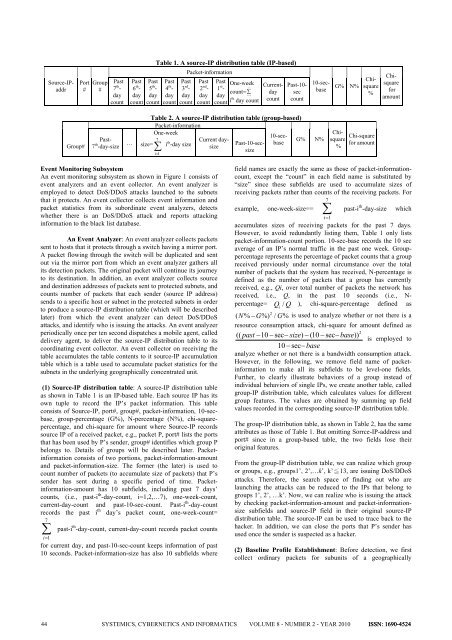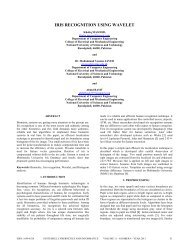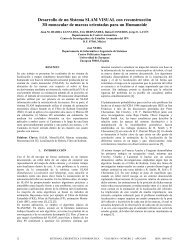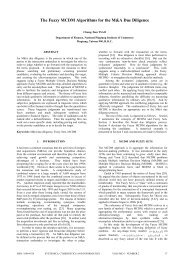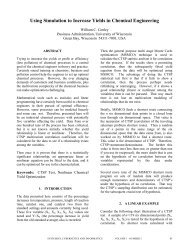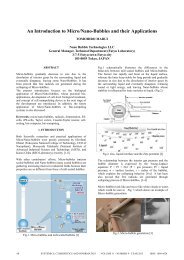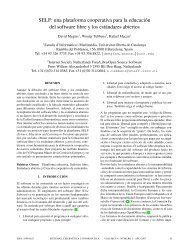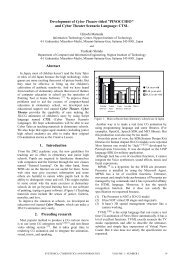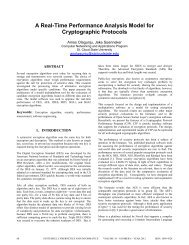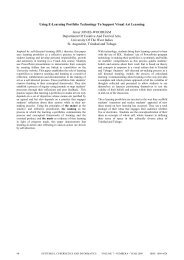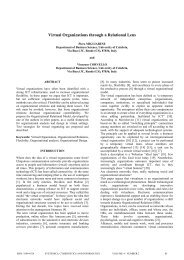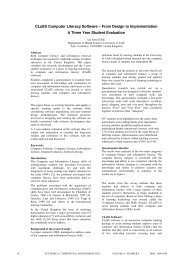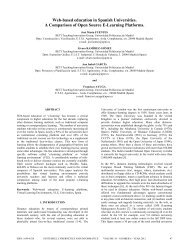A DoS/DDoS Attack Detection System Using Chi-Square Statistic ...
A DoS/DDoS Attack Detection System Using Chi-Square Statistic ...
A DoS/DDoS Attack Detection System Using Chi-Square Statistic ...
You also want an ePaper? Increase the reach of your titles
YUMPU automatically turns print PDFs into web optimized ePapers that Google loves.
Port<br />
#<br />
Group<br />
#<br />
Past<br />
7 th -<br />
day<br />
count<br />
Past<br />
6 th -<br />
day<br />
count<br />
Past<br />
5 th -<br />
day<br />
count<br />
Table 1. A source-IP distribution table (IP-based)<br />
Past<br />
4 th -<br />
day<br />
count<br />
Past<br />
3 rd -<br />
day<br />
count<br />
Packet-information<br />
Past<br />
2 nd -<br />
day<br />
count<br />
Past<br />
1 st -<br />
day<br />
count<br />
One-week<br />
count= ∑<br />
7<br />
i= 1<br />
i th day count<br />
Source-IPaddr<br />
Currentday<br />
count<br />
Past-10-<br />
sec<br />
count<br />
G% N%<br />
10-secbase<br />
<strong>Chi</strong>square<br />
%<br />
<strong>Chi</strong>square<br />
for<br />
amount<br />
Group#<br />
Past-<br />
7 th -day-size<br />
…<br />
Table 2. A source-IP distribution table (group-based)<br />
Packet-information<br />
One-week<br />
10-secbase<br />
size= 7 Current daysize<br />
G% N%<br />
∑ ith -day size<br />
Past-10-secsize<br />
i= 1<br />
<strong>Chi</strong>square<br />
<strong>Chi</strong>-square<br />
for amount<br />
%<br />
Event Monitoring Subsystem<br />
An event monitoring subsystem as shown in Figure 1 consists of<br />
event analyzers and an event collector. An event analyzer is<br />
employed to detect <strong>DoS</strong>/D<strong>DoS</strong> attacks launched to the subnets<br />
that it protects. An event collector collects event information and<br />
packet statistics from its subordinate event analyzers, detects<br />
whether there is an <strong>DoS</strong>/D<strong>DoS</strong> attack and reports attacking<br />
information to the black list database.<br />
An Event Analyzer: An event analyzer collects packets<br />
sent to hosts that it protects through a switch having a mirror port.<br />
A packet flowing through the switch will be duplicated and sent<br />
out via the mirror port from which an event analyzer gathers all<br />
its detection packets. The original packet will continue its journey<br />
to its destination. In addition, an event analyzer collects source<br />
and destination addresses of packets sent to protected subnets, and<br />
counts number of packets that each sender (source IP address)<br />
sends to a specific host or subnet in the protected subnets in order<br />
to produce a source-IP distribution table (which will be described<br />
later) from which the event analyzer can detect <strong>DoS</strong>/D<strong>DoS</strong><br />
attacks, and identify who is issuing the attacks. An event analyzer<br />
periodically once per ten second dispatches a mobile agent, called<br />
delivery agent, to deliver the source-IP distribution table to its<br />
coordinating event collector. An event collector on receiving the<br />
table accumulates the table contents to it source-IP accumulation<br />
table which is a table used to accumulate packet statistics for the<br />
subnets in the underlying geographically concentrated unit.<br />
(1) Source-IP distribution table: A source-IP distribution table<br />
as shown in Table 1 is an IP-based table. Each source IP has its<br />
own tuple to record the IP’s packet information. This table<br />
consists of Source-IP, port#, group#, packet-information, 10-secbase,<br />
group-percentage (G%), N-percentage (N%), chi-squarepercentage,<br />
and chi-square for amount where Source-IP records<br />
source IP of a received packet, e.g., packet P, port# lists the ports<br />
that has been used by P’s sender, group# identifies which group P<br />
belongs to. Details of groups will be described later. Packetinformation<br />
consists of two portions, packet-information-amount<br />
and packet-information-size. The former (the later) is used to<br />
count number of packets (to accumulate size of packets) that P’s<br />
sender has sent during a specific period of time. Packetinformation-amount<br />
has 10 subfields, including past 7 days’<br />
counts, (i.e., past-i th -day-count, i=1,2,…7), one-week-count,<br />
current-day-count and past-10-sec-count. Past-i th -day-count<br />
records the past i th day’s packet count, one-week-count=<br />
7<br />
∑ past-ith -day-count, current-day-count records packet counts<br />
i=1<br />
for current day, and past-10-sec-count keeps information of past<br />
10 seconds. Packet-information-size has also 10 subfields where<br />
field names are exactly the same as those of packet-informationcount,<br />
except the “count” in each field name is substituted by<br />
“size” since these subfields are used to accumulate sizes of<br />
receiving packets rather than counts of the receiving packets. For<br />
7<br />
example, one-week-size== ∑ past-ith -day-size which<br />
i=1<br />
accumulates sizes of receiving packets for the past 7 days.<br />
However, to avoid redundantly listing them, Table 1 only lists<br />
packet-information-count portion. 10-sec-base records the 10 sec<br />
average of an IP’s normal traffic in the past one week. Grouppercentage<br />
represents the percentage of packet counts that a group<br />
received previously under normal circumstance over the total<br />
number of packets that the system has received, N-percentage is<br />
defined as the number of packets that a group has currently<br />
received, e.g., Qi, over total number of packets the network has<br />
received, i.e., Q, in the past 10 seconds (i.e., N-<br />
percentage= Qi<br />
/ Q ), chi-square-percentage defined as<br />
2<br />
( N% − G%) / G%<br />
is used to analyze whether or not there is a<br />
resource consumption attack, chi-square for amount defined as<br />
2<br />
(( past −10 −sec −size) −(10 −sec −base))<br />
is employed to<br />
10 −sec−base<br />
analyze whether or not there is a bandwidth consumption attack.<br />
However, in the following, we remove field name of packetinformation<br />
to make all its subfields to be level-one fields.<br />
Further, to clearly illustrate behaviors of a group instead of<br />
individual behaviors of single IPs, we create another table, called<br />
group-IP distribution table, which calculates values for different<br />
group features. The values are obtained by summing up field<br />
values recorded in the corresponding source-IP distribution table.<br />
The group-IP distribution table, as shown in Table 2, has the same<br />
attributes as those of Table 1. But omitting Sorrce-IP-address and<br />
port# since in a group-based table, the two fields lose their<br />
original features.<br />
From the group-IP distribution table, we can realize which group<br />
or groups, e.g., groups1’, 2’,…k’, k’≦13, are issuing <strong>DoS</strong>/D<strong>DoS</strong><br />
attacks. Therefore, the search space of finding out who are<br />
launching the attacks can be reduced to the IPs that belong to<br />
groups 1’, 2’, …k’. Now, we can realize who is issuing the attack<br />
by checking packet-information-amount and packet-informationsize<br />
subfields and source-IP field in their original source-IP<br />
distribution table. The source-IP can be used to trace back to the<br />
hacker. In addition, we can close the ports that P’s sender has<br />
used once the sender is suspected as a hacker.<br />
(2) Baseline Profile Establishment: Before detection, we first<br />
collect ordinary packets for subunits of a geographically<br />
44 SYSTEMICS, CYBERNETICS AND INFORMATICS VOLUME 8 - NUMBER 2 - YEAR 2010 ISSN: 1690-4524


